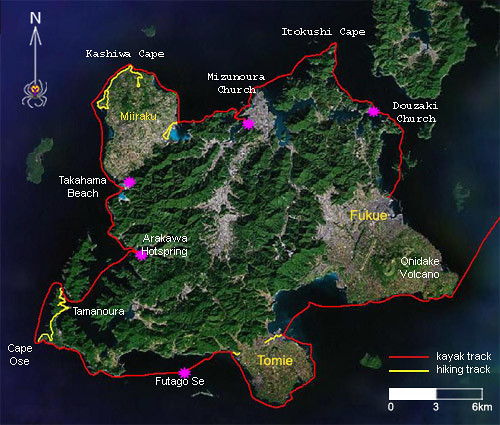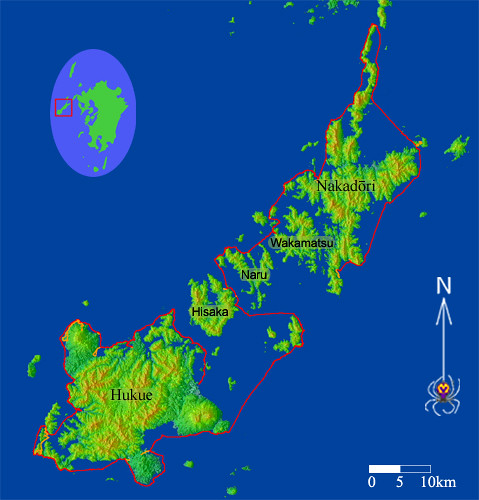Sunday, May 21, 2006
Saturday, May 20, 2006
Golden Gotou Part 1 of 6
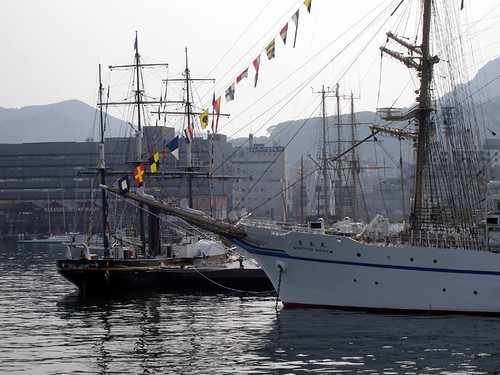
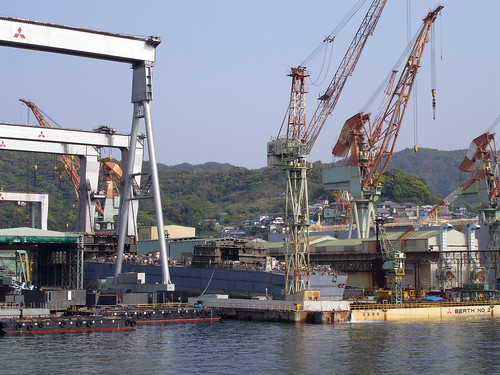
The ferryboat glides out through the crowded Nagasaki harbor, past the proud sailing ships moored to the historic Dejima Wharf for the yearly tall ship festival, past the dry-docks where giant vessels are being welded piece by piece before they can begin pushing their way through the world’s oceans and seas. An enormous empty oil tanker bloats above the water’s surface, the potential liquid volume that will make it sink to its freshly painted water line nearly unimaginable yet barely sufficient to slake the country’s petroleum habit. The ferry turns and picks up speed; we soon pass through the harbor’s entrance so perfectly formed by natural features that (amazingly) no concrete was deemed necessary to improve it. A seascape of small islands and steep shores opens up and begins receding into the hazy distance. The Gotou Islands, still about 90km away to the west, are as yet invisible. Sleepiness overcomes us; after all we spent the night driving around the Ariake Sea and four prefectures -- it was too late after work to catch the ferry that would have cut the approach by about 200km. When we wake after a couple hours’ doze, a barrier of mountains is already visible beyond the ship’s prow. Scanning the nearest with binoculars, sheer, strange-looking cliffs can be seen...cool! This place looks like fun.
We arrive in Hukue, the archipelago’s main island and port, before noon. The cargo folks are extra friendly, and have no problem at all trucking us and our boats a kilometer to the boat ramp, saving us two hours of exertion and pain. We’re surprised by the change in climate; unlike Amakusa, Gotou is completely surrounded by open sea and the air feels damp and fresh. "This place is paradise, you’ll see," says the young port worker in a rare praise of Japan’s inaka or boondocks. The truck rolls off; we don our rubber outfits, crawl into our boats and get on our way.
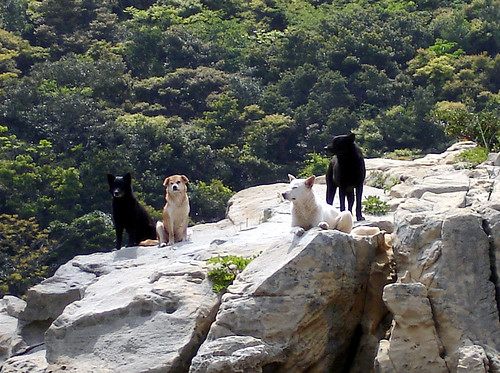
Hugging the shore as we work our way north against the tidal current, we have our first meeting with the islands’ wildlife – a pack of dogs! Unaccustomed to the sight of kayaks, they regard us with curiosity.
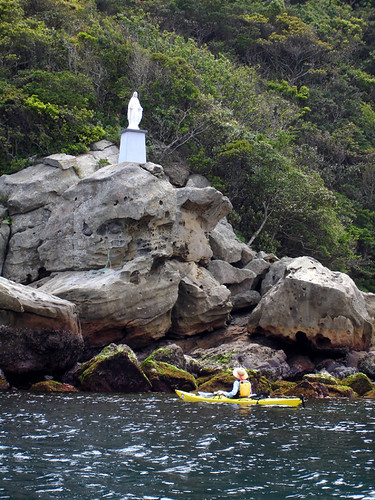
A saintly apparition graces the rocky shore -- a strange sight indeed here in Japan! Yet the Gotou archipelago has been for centuries a refuge for Christians. The Portuguese first brought Christianity to Japan in the 16th century, and this was OK for a while until the Christians began to organize and resist the oppression of the authorities. These skirmishes culminated in the failed, full-scale Shimabara Revolt, which occurred right in our backyard of the Amakusa Islands. In its aftermath tens of thousands of believers were brutally slaughtered and the rest were made to renounce their faith, though many became "hidden Christians" . Looking for peace and quiet, many migrated to Gotou, where they were more or less left alone. Here they have built no fewer than 55 churches, and statues of the Virgin Mary perched on remote coastal rocks and cliffs can be seen here and there. Though we don’t consider ourselves particularly religious, Christianity has nevertheless formed a part of our cultural background and the sight of these relics induces in us a kind of odd nostalgic feeling.
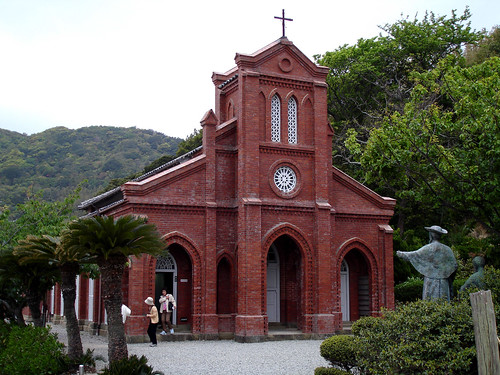
Around the next bend, the Douzaki church meets the eye. It is one of Gotou’s most significant churches historically and architecturally. It was made sometime in the mid-1800’s of authentic Italian brick and somehow this detail stands out in a country where one must get used to buildings (and cars, for that matter) that are either white, beige, some kind of nausea-inducing pastel or else fully blinding fluorescent color. The church faces the water and approaching it by sea seems pleasantly natural; most of its past parishioners would also have come by boat. We pull up on a nearby sandy spit and go inside the church, discovering that it now functions as a museum. It is only as we are leaving that we notice that a modest entrance fee is being levied by the tourist parking lot in the back.
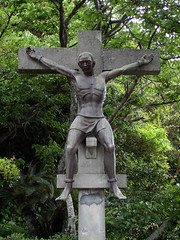
Before setting out again, we contemplate a statue of a Japanese martyr on the cross. Naturally enough, what stands out in our eyes is the oriental reinterpretation of the details in the image whose conventional form remains firmly etched in our memories.
We round the cliffy and wild Itokushi Cape in the northeast corner of Hukue Island and continue in a westerly direction along the rugged coast. A strong south wind is blowing but in our position this is not a serious hindrance or danger so long as we hug the shore. A short struggle around each headland leads to a long section in the lee of the steep cliffs.
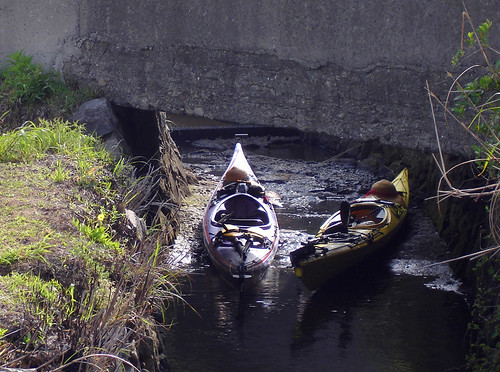
We make a stop at Mizunoura to see the church there; the only place to land is up a small creek running with sewage. The church itself had looked a lot better in the tourist brochures than it does in reality, but it is Sunday morning a nun rings the bell, startling us with its powerful sound. We buy drinks at the jidouhanbaiki and watch parishioners drifting in, dressed in their Sunday best – another thing that one does not readily see in conventional rural Japan. A taxi drops off a churchgoer and the driver begins talking to us. He’s got to wait till the end of the service, an hour, he says, to take his fare back home. Not a Christian himself, mind you. Pretty good living here, between this part-time job and his pension, he makes about $4000 a month, but he blows most of it on pachinko gambling. Not much else to do for fun in a place like this. His candidness is surprising and refreshing -- it is extremely rare for a Japanese to talk about the money he makes, or spends.
The wind freshens to 20 knots. We’re in no great hurry since there is no way we will be able to continue past Cape Kashiwa, a point about 10km away where the coast turns south. We try paddling directly into the wind on our approach to Miiraku, only to discover we are staying put as if on a treadmill. We ferry glide the bay instead, land north of the port and kill a couple of hours walking aimlessly around the nondescript town.
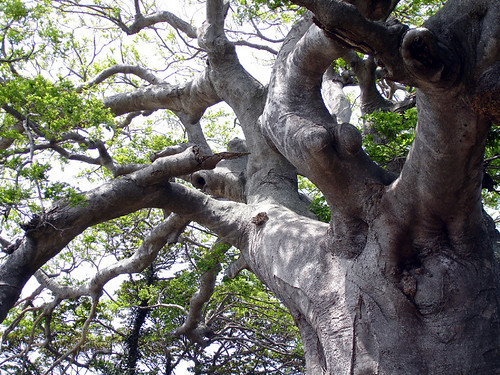
We find a large tree whose massive branches are so stiff they barely move in the wind, though at a nearby construction site a sheet metal sign gets torn in half. Eventually we even find the "Hometown Pavilion" , a kind of local museum, restaurant, and civic center all rolled into one. There is a historical display about the importance of Gotou as the departure point for Japanese delegations to China (the few that there were) centering on an artful model of a type of junk they had used for the purpose. During the centuries of Japan’s virtual isolation from the rest of the world the building of oceangoing vessels was prohibited so the sight of one of these must have been rare indeed. In a subtle twist, the flower planters all around town also have the same trough-like, flat-bottomed shape as did these historic boats.
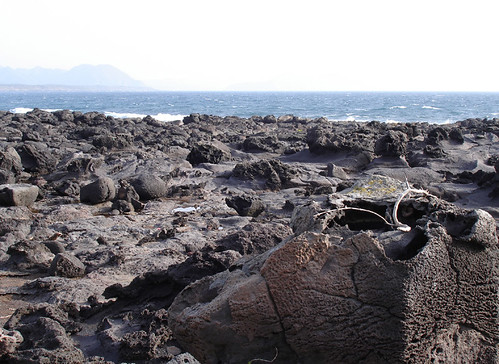
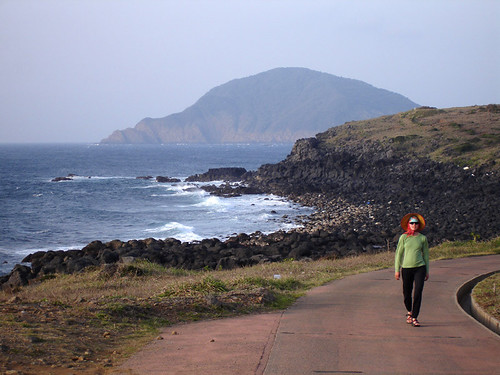
The coastline is now low and composed entirely of black lava rocks so tough-looking it seems like they could endure the pounding of the sea forever. At Kashiwa we verify that further progress by sea is impossible: howling wind and huge waves would be directly against us. We leave the boats in the fishing port and set off on a pleasant walk along the coast.
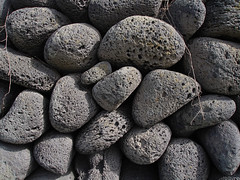
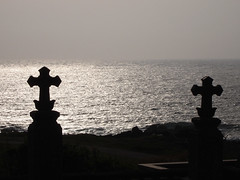
The late afternoon light reveals to us many small spectacles along the way: round black lava boulders stacked attractively in an old terrace wall; crosses in a Christian cemetery stand out against the shining sea.
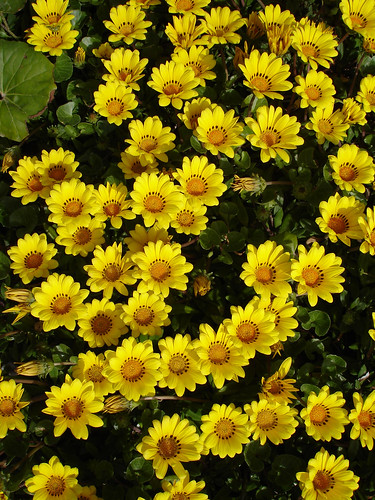
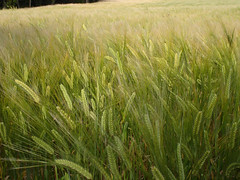
In the villages, brilliant yellow flowers seem to cover every spare piece of ground, and in the fields, barley undulates in the gusty wind, the porous volcanic soil being unsuitable for growing the much-preferred rice.
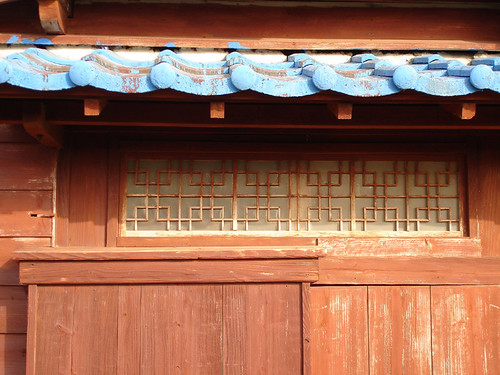
A traditional cedar-sided village house such as this one, now found only in the remote, forgotten parts of the country, illustrates the principle of wabi, an interplay of simple rough colors and textures that used to be central to Japanese esthetic thinking. Unfortunately, during the 20th century Japan has been brainwashed to worship Western values, and wabi now basically means only old, dirty, and poor. The focus has shifted to the polished and artificial, in a way that is so artless it can only be called hideous. Houses are clad in shiny metal and plastic of the most unnatural texture and color. To an esthetically aware person this looks heinous right from the start and even to most Japanese, it starts looking bad after only a few years as the vagaries of Japan’s hot, wet climate add their own to the surface finish. As a result, great effort is expended to keep things perpetually new. For example, houses are typically torn down and rebuilt every 15-20 years. It sounds incredible, but in the larger cities one would be hard-pressed to find a building over 50 years old that is not a shrine, castle, or some such. This triumph of materialism is great for the economy, but it is also horribly wasteful and disastrous for what’s left of the country’s environment. In the meanwhile, old houses age gracefully on tiny islands like Gotou, the passing seasons only adding to their charm.
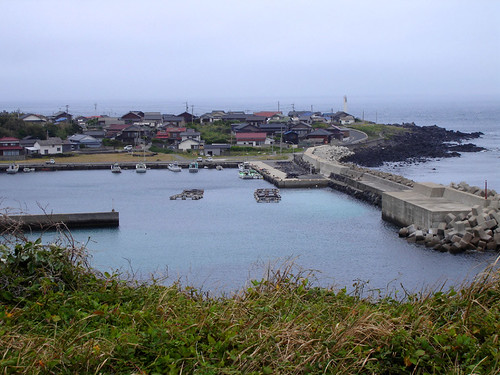
We hang out for one more day in Kashiwa, while the south wind howls on. Camping on the flat concrete of the port, we have been noticed by the local fishermen. Also restless because they can’t go out in this weather, they poke about the place and strike up idle conversation. None of them seems too surprised by our adventure, a feature that seems common to most rural folk. A woman from the nearest house brings us hot food for the second time, but she thinks the travelers she met yesterday were different people! Must have been the farming hats we were wearing then; these seem to instantly metamorphose us into Japanese, even at close range. Anyway her kindness is very sweet. A jolly-looking man says we’ll be stuck here another day, because tomorrow the will change to northeast and blow very fiercely. Such a wind would indeed rough up this coast, but beyond the cape to the southwest where it is rough now, things ought to calm down in the land’s wind shadow. We plan to use the brief period of the wind’s shifting to make our escape. Timing is everything.
